Summary
Background. Evidence of tSAH on an admission CT scan seems to be an early predictor of evolving posttraumatic lesions. Detection of these changes requires serial CT scanners. The goal of our study was to determine the optimal timing of follow-up CT scans in head injured patients with traumatic subarachnoid haemorrhage (tSAH).
Method. We reviewed the initial and follow-up CT scans in 141 patients with closed head injuries and evidence of tSAH on the initial CT scan. We used the Marshall classification to determine diffuse and focal injuries. The “worst CT scan”, defined as the CT examination in which midline shift, cistern compression and/or intracranial focal lesions were greater, was also determined. Any worsening of the admission CT findings, occurring when the “worst CT examination” did not correspond to the initial CT study, was considered as a “CT evolution”. Any “CT evolution” associated with a variation from a lower to a higher score in the Marshall classification score was indicated as a “significant CT evolution”.
Findings. The median time between injury and the first CT scan was 1.3 (IQR 1.5) hours. A CT evolution was found in 83/141 (58.9%) patients in whom the median time between the initial and worst CT scans was 27.7 hours (IQR 69.2 hours). The worst CT studies were seen more often at 12–24 hours and at 24–48 hours after the admission CT scan than in later studies. A similar temporal profile was observed when the timing of the “worst CT scan” was evaluated in 38/83 (45.8%) subjects with a “significant CT evolution”.
Interpretation. Our findings show that an early admission CT scan did not represent the full extent of the posttraumatic damage in more than half of our patients. They also suggest that to identify these changes in head injured patients with tSAH, CT scans should be repeated at 12–24 and possibly also at 24–48 hours from the admission CT examination to allow early detection and evacuation of evolving intracranial lesions.
Similar content being viewed by others
Author information
Authors and Affiliations
Rights and permissions
About this article
Cite this article
Fainardi, E., Chieregato, A., Antonelli, V. et al. Time course of CT evolution in traumatic subarachnoid haemorrhage: a study of 141 patients. Acta Neurochir 146, 257–263 (2004). https://doi.org/10.1007/s00701-003-0207-y
Published:
Issue Date:
DOI: https://doi.org/10.1007/s00701-003-0207-y




